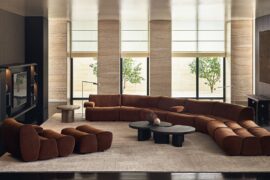Work for the world’s largest dome at Singapore’s new National Stadium has begun
October 22nd, 2012
A project of an ambitious scale is currently underway along Marina Channel to the northeast of the city’s downtown.
Led by Arup, the roof for Singapore’s new National Stadium has commenced and when completed, it will be the largest dome roof in world.

The ultra-thin retractable steel dome will measure 310m wide. It will provide shade and shelter to the 55,000-seat stadium and surrounding community spaces. The 20,000m2 moving roof will also be clad in a multi-layer ETFE pillow and incorporate a matrix of LED lights, making it one of the largest addressable LED screens in the world.

According to Arup, the major drivers in the design were the local climate, the site location and the proposed event programme.
“The tropical climate in Singapore poses a challenge in the design of the National Stadium. People will only enjoy the stadium experience if the environmental conditions are right. We wanted to keep the rain and heat out, but we also wanted it to be an open and dynamic space,” adds Clive Lewis, Arup’s lead Sports Venue Designer for the project.
“After extensive research into comfort expectations and energy in use, we realised that a naturally ventilated stadium with localised cooling gave us the best solution for the local climate in Singapore. By incorporating a moving roof, the stadium will be further protected from the harsh climatic conditions, allowing events to be hosted during the hottest parts of the day.”

The structure’s architectural design and engineering was done using advanced parametric modeling software, as well as in-house software that Arup had specially developed for the project. The result is a super efficient shell dome structure. The dome has a total steel weight of 8,057 metric tons. At a structural weight per square metre of just over 100kg/m2, this is considered efficient even for a roof that is half this span.
In another first, the new National Stadium will be the only one in the world to be custom-built to host football, rugby, cricket and athletic events in one single venue.

Aside from the National Stadium, the S$1.33b Sports Hub will also feature:
– A 3,000-capacity indoor world tournament standard Aquatic Centre, expandable to 6,000 capacity for specific events.
– A 3,000-capacity Multi Purpose Indoor Arena (MPIA) which will be scalable and flexible in layout.
– A 41,000sqm of commercial retail space.
– A Water Sports Centre for athletes and the public.
– The existing 12,000-capacity Singapore Indoor Stadium.
– A Sports Information & Resource Centre (SIRC), with sports library and museum.
The Sports Hub is expected to be completed by 2014.

Arup
arup.com
INDESIGN is on instagram
Follow @indesignlive
A searchable and comprehensive guide for specifying leading products and their suppliers
Keep up to date with the latest and greatest from our industry BFF's!

Welcomed to the Australian design scene in 2024, Kokuyo is set to redefine collaboration, bringing its unique blend of colour and function to individuals and corporations, designed to be used Any Way!

A longstanding partnership turns a historic city into a hub for emerging talent
The internet never sleeps! Here's the stuff you might have missed

‘What a Ripper!’ by comedian and architecture advocate Tim Ross explores Australia’s rich legacy of local product design.

Poliform has mastered the art of seating that is both elegant and adaptable. These five designs highlight the balance between aesthetic impact and everyday ease.